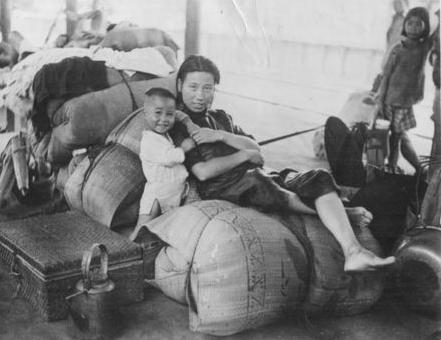
Second Sino-Japanese War: Campaigns -- Ichi-Go (April-November 1944)

Figure 1.--In the middle of the Japanese Ichi-Go offensive, this Chinese woman and her baby are tyring to flee the advancing Japanese Army. The press caption read, "Waiting for transportation - or Japs: his Chinese mother and her child are seated beside a railroad somewhere in the path of the Japanese advance from Changsha and Henyang. If she fails to get a lift before the Japs reach her -- who knows? The Japs are making this determined drive in attempt to knock out American air bases in southeastern China. Fear of the U.S. Superfortresses is behind the offensive." Note that Ichi-Go continued even after the Marianas were in American hands.
|
|
The Japanese Ichi-go Offensive diverged from their normal rice offensives that they had persued in China. It was a major effort late in the War, the last important Japanese offensive. Even with the Burma Road closed, General Chennault�s 14th Air Force was conducting effective raids on Japanese positions. American plans called for initiating the strategic air campaign against the Japanese Home Islands from new Chinese bases being built by by work gangs of Chinese laborers. This was to begin as soon as the new long-range B-29 bomber became available and the Ledo Road connected with the old Burma Road so the bases could be supplied. (The American capture of the Marianas made the Chinese bases much less important and avooded the logitival nighmare of sipplying air bases over the Himalayas.) The Japanese who still held the Marianas decided to seize the new Sino-American airbases that Chennault had begun using. The Japanese launched Ichi-go with 17 divisions with 0.4 million men. They had 12,000 vehicles and 70,000 horses. The Japanese force was given three major objectives:
1) Control the entire length of the Beijing and Hong Kong rail line,
2) Link the forces in China with those in occupied French Indochinavand open up an overland supply eoute, and
3) Seize control of Sino-American air fields in south-central China. Given the state of the war, the operation made some sense. The Germans were not yet defeated and still held France and much of Eastern Europe. The Imperial Navy was still a powerful force. They has rebuilt and enlarged their carrier fleet. The Imoerial Fleet was preparing a mahor operation to defend the Marianas. Many Japananese commanders were stull hopeful that the Maraianas could be held. The greatest in early 1944 threat to the Home Islands came from the sino-American airfields in southern China. The Japanese forces were ordered to destroy crops and other food supplies that could not be seized. The food situation in Nationalist China was becoming desperate and thre was still no way for America to get food into China as the Japanese controlled the ports. The major battles were Henan (April-May), Changsha (June-August), and Guilin-Liuzhou (November). The Japanese committed terrible attroicities against civilians during the offensive. The Japanese achieved most of their objctives and serioudly weakned the Nationalists. The success of the Japanese exposed the weakness of the Nationalist forces. The Chinese units that Stillwell had supplied and trained in Burma and India fought well. The unreformed Nationalist divisions outside of stillwell's control and not as well supplied simply desintegrated and melted away in the face of the Japanese offensive. The Nationalists reported 0.5 million casualties and some of these were reportedly the best divisions in Chiang's army. None of the accomplishments, however, in any way benefitted the Japanese war effort. The real threat to Japan came from the relentless Pacific advance of the Americans. Ichi-go used Japan's scarce resources in China which was far far from the real threat. By the end of Ichi-go, Japan's hold on Burma was crubling. the Marianas were in American hands, the Imperial Fleet no longer existed, and the Philippines was being liberated.
CIH -- WW II

Navigate the CIH World War II Section:
[Return to Main China World War II 1940-45 page]
[Return to Main China World War II page]
[Return to Main World War II Japan page]
[Return to Main Pacific War page]
[Biographies]
[Campaigns]
[Children]
[Countries]
[Deciding factors]
[Diplomacy]
[Geo-political crisis]
[Economics]
[Home front]
[Intelligence]
[Resistance]
[Race]
[Refugees]
[Technology]
[Bibliographies]
[Contributions]
[FAQs]
[Images]
[Links]
[Registration]
[Tools]
[Return to the Main World War II page]
[Return to Main war essay page]
Created: December 29, 2002
Last updated: 7:35 AM 7/10/2020



